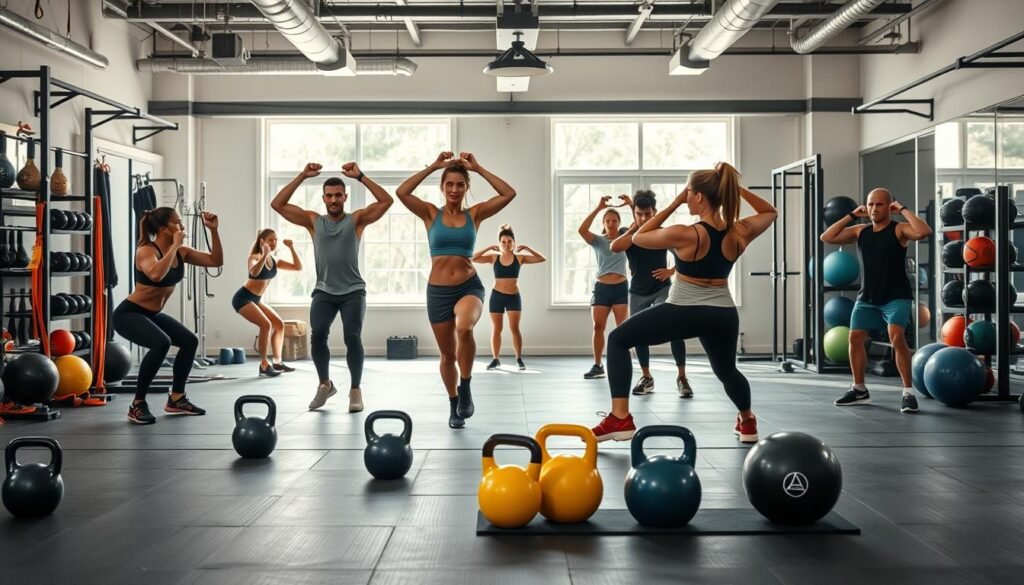Did you know that 90% of adults struggle with basic physical tasks by age 50? This is because they lose muscle strength. Functional fitness is changing how we do strength training. It turns workouts into real-life movements, not just isolated muscle exercises.
Functional strength training is more than just going to the gym. It helps build muscle strength for everyday tasks like carrying groceries or playing with kids. Unlike old-school workouts, these routines work many muscles at once. This boosts your body’s performance overall.
Your daily life needs more than just working out one muscle at a time. Functional fitness gets your body ready for everyday challenges. It improves balance, coordination, and flexibility. By doing exercises that mimic natural movements, you build muscle strength for everyday tasks.
Key Takeaways
- Functional fitness mimics real-world movement patterns
- Engages multiple muscle groups simultaneously
- Improves overall body coordination and balance
- Requires minimal to no equipment
- Adaptable to different fitness levels and ages
Understanding Functional Fitness and Its Role in Daily Life
Functional fitness changes how we see exercise. It links physical training to our daily lives. Unlike old-school workouts, it focuses on practical strength for real-life challenges.
What Makes Training Functional
Functional fitness is a new way to build strength. It uses natural body movements. Key traits include:
- Multi-joint exercises engaging multiple muscle groups
- Movements that replicate daily activities
- Exercises improving overall mobility and core stability
- Scalable workouts for different fitness levels
Connection Between Exercise and Daily Activities
Your fitness routine affects daily tasks. Brad Schoenfeld, a fitness expert, says exercises are functional based on their use. Training muscles together boosts your ability to lift, climb stairs, and stand straight.
Benefits for Overall Health and Wellness
Functional strength exercises bring many health benefits:
- Reduced risk of injury prevention
- Improved metabolic rate
- Enhanced balance and coordination
- Better motor skills
Functional fitness is about creating a stronger, more adaptable body that performs optimally in daily life.
Experts say do five to six functional exercises three to four times a week. This makes your body stronger and more capable.
The Science Behind Functional Strength Training for Everyday Movements
Functional strength training changes how you see fitness. It focuses on muscle endurance and making everyday movements easier. This method is different from traditional weightlifting because it builds strength for daily life.
This training method works by engaging many muscles at once. It’s not like isolated exercises. It prepares your body for real-life challenges, making you stronger and more resilient.
“Functional training isn’t just about lifting weights – it’s about preparing your body for life’s physical demands.”
Key Scientific Insights
- Engages 4 critical movement patterns:
- Locomotion
- Level change
- Upper extremity function
- Rotation
- Combats natural muscle atrophy (sarcopenia)
- Improves balance and coordination
- Reduces injury risk
Studies show functional strength training boosts movement and physical performance. It trains your body for tasks like squatting and lifting. This way, you’re better prepared for everyday challenges.
The beauty of functional training lies in its practical approach to building strength that matters in your everyday life.
In the United States, this training is very popular. Fitness centers offer classes to build practical strength. This makes daily tasks easier and more manageable.
Core Principles of Functional Training and Exercise Benefits
Functional fitness changes how you do strength training. It focuses on movements that help you in everyday life. Your body learns to work together better, getting ready for daily challenges.
Functional training is more than just building muscle. It focuses on full-body movements that boost your physical skills. It combines bodyweight training, mobility drills, and resistance training for a complete fitness plan.
Multi-Joint vs Single-Joint Movements
Knowing about movement types is key in functional training. Multi-joint exercises work many muscles at once. This gives better benefits than single-joint movements:
- Multi-joint exercises mimic natural movement patterns
- Engage multiple muscle groups at once
- Improve overall strength and coordination
- Enhance functional movement capabilities
Compound Exercise Benefits
Compound exercises like squats, deadlifts, and lunges are vital in functional training. These exercises:
- Work multiple muscle groups simultaneously
- Improve balance and core stability
- Increase metabolic rate
- Develop practical strength for everyday activities
Building Real-World Strength
Functional strength training prepares your body for real-life needs. It combines resistance training with movement-based exercises. This builds strength that helps with daily tasks.
“Functional fitness is about training movements, not muscles.”
Key principles include training in multiple planes of motion. Also, keep full range of motion and challenge your body with varied exercises.
Essential Upper Body Functional Exercises
Working on your upper body can change how you do daily tasks. It’s all about building strength for everyday life. Understanding the right movements is key.

Functional exercises are like real-life actions. They get your body ready for daily tasks. Your core is important for these movements.
- Kettlebell shoulder press
- TRX rows
- Negative press-ups
- Battle rope variations
“Strength training is not about building muscles, but about building capability for life’s demands.” – Fitness Expert
Each exercise works on different muscles. This helps you do daily tasks better. For example, the kettlebell shoulder press makes your shoulders stronger.
| Exercise | Sets | Reps | Rest Period |
|---|---|---|---|
| Kettlebell Shoulder Press | 2 | 15 | 60 seconds |
| TRX Rows | 2 | To failure | 60 seconds |
| Negative Press-Up | 2 | 12 | 60 seconds |
Doing these exercises regularly boosts your strength for daily tasks. The aim is to make your body stronger for everyday activities.
Functional fitness, strength training, daily activities, muscle strength
Functional fitness changes how you see strength training. It focuses on movements that help you in everyday life. Your body becomes strong and ready for any challenge.
Building Practical Strength for Daily Tasks
Functional strength training is more than just building muscles. It gets your body ready for real-life actions. Exercises are designed to match your daily activities, making them easier.
- Mimics natural movement patterns
- Improves overall muscle coordination
- Reduces injury risk during daily activities
Integrating Movement Patterns
Good functional training includes exercises that improve your body’s flexibility. By doing movements in different directions, you become more flexible and strong. This helps you handle various physical tasks better.
“Functional fitness is about training for life, not just for the gym.” – Fitness Expert
Progressive Overload Techniques
To keep getting stronger, use progressive overload. This means making your workouts harder by adding weight, doing more reps, or trying new exercises.
| Technique | Benefit |
|---|---|
| Increasing Repetitions | Builds muscular endurance |
| Adding Weight | Enhances muscle strength |
| Reducing Rest Time | Improves cardiovascular fitness |
By using these methods, you’ll have a strong and effective fitness routine. It will prepare you for any physical challenge life throws your way.
Lower Body Exercises for Enhanced Daily Function
Building strength in your lower body is key for better daily movements. Leg exercises boost muscle endurance, making everyday tasks easier and more confident.
A study found that 15-20 minutes of strength training, three times a week, can greatly improve bone density and physical performance. Lower body exercises do more than build muscle. They lay the groundwork for better movement in your daily life.
“Functional training is about preparing your body for real-world challenges, not just lifting weights.” – Fitness Experts
Essential Lower Body Functional Movements
- Squats: Mimics sitting and standing motions
- Lunges: Improves balance and leg strength
- Deadlifts: Enhances lifting and bending capabilities
- Step-ups: Builds power for climbing stairs
When planning your lower body workout, choose compound exercises that work many muscles at once. Experts say pick 3-5 exercises for each leg workout. Aim for 3 sets of 8-12 reps to effectively engage muscles.
Performance Tips for Maximum Results
- Warm up with 5 minutes of light cardio
- Perform dynamic stretching
- Use proper form to prevent injury
- Gradually increase resistance
Adding these functional movements to your routine will not only strengthen your body but also enhance core stability, mobility, and overall performance. The aim is to have a body that moves well in everyday life.
Bonus Tip: Focus on quality repetitions over quantity to boost muscle endurance and functional strength.
Core Stability and Balance Training Fundamentals
Your body’s core is key to moving well and staying fit. Learning about core stability, balance, and mobility can boost your performance and lower injury risks.
Core stability is more than just abs. It’s about strengthening muscles around your spine and pelvis. This creates a strong base for all activities.
Importance of Core Strength
Strong core muscles offer many benefits for everyday life:
- They help keep your posture right and body aligned.
- They lower the chance of back pain.
- They boost your physical performance.
- They support balance and stability.
Balance Exercise Progression
Getting better at balance is about improving how your body feels and moves. Start with simple moves and then make them harder.
| Exercise Level | Difficulty | Core Engagement |
|---|---|---|
| Beginner | Modified Plank | Low |
| Intermediate | Single-Leg Balance | Moderate |
| Advanced | Dynamic Stability Moves | High |
Mobility Enhancement Techniques
Mobility exercises add to core strength by letting you move more freely and relax muscles. Use dynamic stretches and drills to help your core training.
*”Core strength is not about six-pack abs, but about creating a stable foundation for all movement.”*
Adding core stability, balance, and mobility to your workout can greatly enhance your fitness and cut down on injuries.
Creating Your Functional Training Program

Creating a good functional training program needs careful planning and knowing your fitness goals. Your workouts should build strength that helps in daily life.
To make a solid fitness plan, keep these tips in mind:
- Know your current fitness level
- Set clear, reachable fitness goals
- Choose exercises that work many muscles
- Focus on proper form over heavy weights
Start with basic bodyweight exercises for beginners. These help build core strength and stability. Progressive overload is key to improving your functional training.
“Functional fitness isn’t about looking good—it’s about moving better in real-world scenarios.” – Fitness Expert
For the best results, follow these workout guidelines:
- Do 2-3 strength training sessions a week
- Include different movement patterns
- Make sure to rest enough between sessions
- Slowly increase the intensity of your workouts
Advanced users can try complex moves like single-leg Romanian deadlifts and front squats. These exercises push your functional strength to the next level.
Remember, being consistent and using the right technique is more important than lifting the heaviest weights. Your aim is to build a fitness routine that boosts your daily performance.
Conclusion
Functional fitness is more than a trend. It’s a science-backed way to improve how you move every day. Studies from 145 research papers show how specific exercises boost your physical skills. They improve speed, strength, power, balance, and agility.
Your journey in functional fitness is about gaining practical strength. This strength helps you in real-life situations. High-intensity workouts have shown to increase muscle strength and power. They make you more resilient and better at everyday movements.
Functional training makes your body more capable and adaptable. It’s great for athletes and anyone wanting to move better. By doing exercises that mimic daily activities, you build strength that matters. This strength helps you do tasks more efficiently and safely.
As fitness research grows, functional training stays at the top. Sticking with it can make you stronger, move better, and feel more confident. It turns you into a more capable version of yourself.




